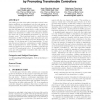Free Online Productivity Tools
i2Speak
i2Symbol
i2OCR
iTex2Img
iWeb2Print
iWeb2Shot
i2Type
iPdf2Split
iPdf2Merge
i2Bopomofo
i2Arabic
i2Style
i2Image
i2PDF
iLatex2Rtf
Sci2ools
GECCO
2010
Springer
2010
Springer
Crossing the reality gap in evolutionary robotics by promoting transferable controllers
The reality gap, that often makes controllers evolved in simulation inefficient once transferred onto the real system, remains a critical issue in Evolutionary Robotics (ER); it prevents ER application to real-world problems. We hypothesize that this gap mainly stems from a conflict between the efficiency of the solutions in simulation and their transferability from simulation to reality: best solutions in simulation often rely on bad simulated phenomena (e.g. the most dynamic ones). This hypothesis leads to a multi-objective formulation of ER in which two main objectives are optimized via a Pareto-based Multi-Objective Evolutionary Algorithm: (1) the fitness and (2) the transferability. To evaluate this second objective, a simulation-to-reality disparity value is approximated for each controller. The proposed method is applied to the evolution of walking controllers for a real 8-DOF quadrupedal robot. It successfully finds efficient and well-transferable controllers with only a fe...
| Added | 19 Jul 2010 |
| Updated | 19 Jul 2010 |
| Type | Conference |
| Year | 2010 |
| Where | GECCO |
| Authors | Sylvain Koos, Jean-Baptiste Mouret, Stéphane Doncieux |
Comments (0)

